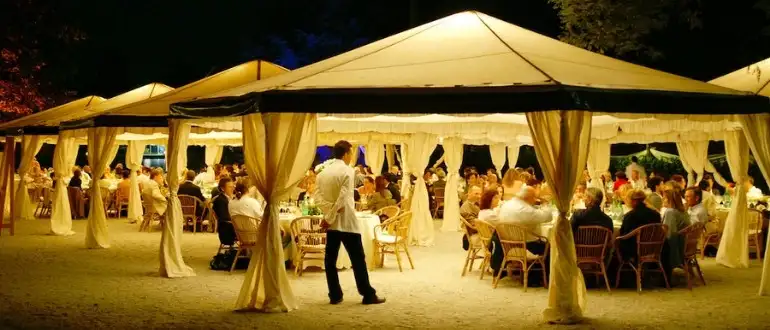Planning an event and unsure about the right tent size for 50 guests? Stress no more.
Our detailed guide demystifies the selection process, considering various influencing factors. Discover the perfect fit to make your event memorable and comfortable.

What Size Tent Do I Need for 50 Guests?
For a gathering of 50 guests, you would require a tent of at least 500 to 750 square feet. This size accommodates a sit-down dinner and space for basic amenities. Additional features like a dance floor or buffet area would require extra space.
Tent size chart for 50 guests:
| Event Type | Average Space Per Person (sq. ft.) | Minimum Tent Size For 50 Guests (sq. ft.) |
|---|---|---|
| Cocktail Party | 5 | 250 |
| Buffet Dinner | 8 | 400 |
| Sit-Down Dinner | 10 | 500 |
| Ceremony Seating | 6 | 300 |
>> What tent size accommodates 75 guests?
Different Types of Tents Suitable for 50 Guests
Here are some of the most common types of tents that are suitable for 50 guests:
Pop-Up Tents
Pop-up tents are also known as instant or easy-up tents. They are very popular because they are easy to set up and take down.
They usually come with a metal frame that pops open when you unfold it and locks into place with pins or clips.
Pop-up tents are great for casual events such as picnics, barbecues, or tailgating parties. They are also very affordable and portable.
Pop-up tents have some drawbacks as well. They are not very sturdy or durable and they may not withstand strong winds or rain.
They also have limited sizes and shapes and they may not fit well with your party theme or layout.
Pole Tents
Pole tents are also known as tension or peak tents. They are one of the most traditional and elegant types of tents.
They have a high center pole that creates a peak in the middle of the tent and several side poles that support the fabric roof.
Pole tents create a spacious and airy feel inside the tent and they can accommodate various sizes and shapes of tables and chairs.
Pole tents are ideal for formal events such as weddings, receptions, or ceremonies.
They are also very versatile and customizable and they can fit well with any party theme or layout.
Pole tents have some drawbacks as well. They require a lot of space and clearance around the tent to stake down the poles and ropes.
They also have center poles that may obstruct the view or interfere with the traffic flow inside the tent.
Frame Tents
Frame tents are also known as freestanding or clearspan tents. They have a metal frame that supports the fabric roof without any center poles or ropes.
Frame tents create a clear and open space inside the tent and they can accommodate various sizes and shapes of tables and chairs.
Frame tents are ideal for events that require a lot of flexibility and customization, such as trade shows, exhibitions, or corporate events.
They are also very sturdy and durable and they can withstand strong winds or rain. Frame tents have some drawbacks as well.
They are more expensive and heavier than pole tents and they may require professional installation and removal.
They also have a more industrial and less elegant look than pole tents.
Stretch or Tension Tents
Stretch or tension tents are also known as sailcloth or Sperry tents.
They are a modern and stylish type of tent that has a flexible fabric roof that stretches and curves over the poles and stakes.
Stretch tents create a unique and dynamic look that can enhance any party theme or layout.
They are also very adaptable and versatile and they can fit in any space or terrain.
Stretch tents are ideal for events that require a lot of creativity and flair, such as festivals, concerts, or parties.
They are also very lightweight and easy to set up and take down. Stretch tents have some drawbacks as well.
They are more expensive and less available than other types of tents and they may not be suitable for extreme weather conditions.
Yurts
Yurts are also known as round or circular tents. They are a traditional type of tent that originated from Central Asia.
They have a wooden frame that supports a fabric roof that is usually decorated with colorful patterns.
Yurts create a cozy and intimate feel inside the tent and they can accommodate various sizes and shapes of tables and chairs.
Yurts are ideal for events that require a lot of warmth and charm, such as family reunions, retreats, or camping trips.
They are also very eco-friendly and sustainable and they can blend well with the natural environment. Yurts have some drawbacks as well.
They are more difficult and time-consuming to set up and take down than other types of tents and they may not be very spacious or comfortable for large groups of people.
How to Measure the Perfect Tent Size for 50 Guests?
Accounting for Tables, Chairs, and Other Furniture
First, calculate the space for tables, chairs, and furniture. Know the dimensions and quantity of each item.
For instance, a six-seat round table occupies 60 x 60 inches. Multiply this by the number of tables, then convert to square feet.
Don’t forget to add space for chairs and aisles, typically 10 square feet per person.
Incorporating Additional Features: Stage, Dance Floor, and Buffet Area
Next, consider extra features like stages or dance floors. Understand their dimensions and the average space per person.
A 15 x 15 feet dance floor needs 4 square feet per person. Calculate the total area each feature will occupy, and add extra space for movement.
Safety and Comfort Considerations
Safety is paramount. Ensure there’s sufficient space for comfortable movement, emergency exits, and accommodating special needs.
Always adhere to safety regulations.
Buffer Space: Why Extra Square Footage is Wise
Adding buffer space is crucial. Unforeseen circumstances like extra guests or unexpected needs can arise.
Adding 10% of your total tent size as buffer space is a smart move to avoid any discomfort or hassle.
Factors Influencing Tent Size Selection for 50 Guests
Consider any factors that may influence your tent size selection for 50 guests. These factors include:
Event Type
The type of event is a decisive factor. For a wedding, a large tent with elegant high peaks is suitable. It creates an atmosphere of grandeur and comfort.
For a casual outdoor party, a simple pop-up tent or canopy would work. It offers a relaxed setting. Consider the event’s formality before choosing.
Tent Accessories
Tent accessories enhance the ambiance. Planning to use chandeliers or sound systems? You’ll need space for these.
They might require extra room for safe installation. Simple accessories like small lights or banners don’t take up much space. They fit easily in most tents.
The accessories you pick can dictate the size and type of your tent.
Weather Considerations
Weather is unpredictable but crucial. Sunny day? Tents with side panels open are good. They allow for a breeze. Expecting wind or rain?
Tents with solid, waterproof walls are best. They protect your guests. The expected weather conditions can greatly influence your choice of tent.
Ground Surface
The ground surface affects tent installation. Soft, flat ground is ideal for stakes and poles. Hard or uneven ground? Weights or specific bases are needed.
These adaptations can influence the size and type of tent you select. Assess the ground’s condition in your decision process.
Local Regulations
Local regulations are often overlooked. Some areas have strict rules on tent sizes and styles. Others might require permits. Research these in advance.
This will ensure you comply with laws and community standards. Staying within regulations will narrow down your options effectively.
Style and Theme of the Event
The style and theme of your event should be reflected in your tent. Hosting a vintage-themed party? A traditional pole tent with draped fabric is fitting.
Want a minimalistic modern vibe? Clear-top tents are perfect. They offer sleek lines and visibility.
The aesthetic of your event can greatly dictate the style of tent you need.
Ease of Setup
Setup ease varies between tents. Pop-up tents are fast and easy. They’re perfect for short events. Larger, pole tents require more setup time.
They’re better for longer, grander events. Consider how much time and manpower you have. Your capability to set up a tent should influence your selection.
Budget Constraints
Your budget is a boundary. High-end tents with extensive features cost more. Simple, functional tents are budget-friendly.
Determine your spending limit early. This helps in filtering options. Balancing cost and quality is key in selecting the right tent.
Tent Availability
Finally, availability can change your plans. Popular tent styles get booked quickly, especially in peak seasons. Start your search early.
Have a second option in mind. The supply of tents can affect your final decision. Don’t forget to plan for this!
>> What is the best size tent for 100 guests?
Video: What Size Tent For 50 Guests
FAQs About Choosing A Tent For 50 Guests
Do I need a permit to set up a tent for 50 guests?
This depends on your local regulations. Some areas require permits for temporary structures like event tents.
Should I rent or buy a tent for 50 guests?
Renting a tent is often the more practical choice for a one-time event with 50 guests. Buying a tent is a significant investment and may not be cost-effective for occasional use.
What other equipment or accessories do I need with the tent?
Depending on your event, you may need additional items like tables, chairs, lighting, flooring, heating or cooling systems, and decor.
How early should I reserve the tent for my event?
It’s advisable to book your tent as early as possible, especially during peak event seasons.
How can I decorate the tent for a 50-guest event?
Decorating a tent can be creative and personalized. Consider lighting, drapery, flowers, and table settings to create the desired ambiance.
Final Thoughts
Choosing the right tent size for 50 guests means considering several factors.
From weather to ground surface, local regulations to your event’s style, each aspect is crucial.
Remember, the perfect tent makes your event comfortable and unforgettable.
Now you’re equipped with the knowledge to make an informed decision, ensuring your gathering is a hit!

